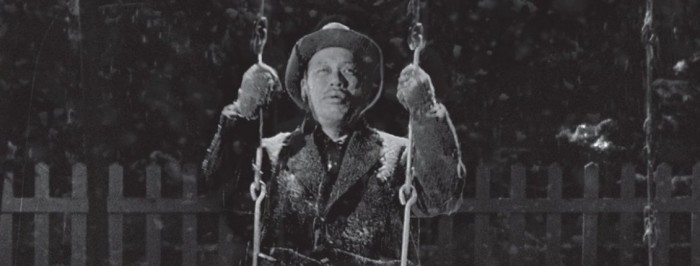“A man dying of cancer searches for life meaning.” When condensed into this single phrase, the plot of Ikiru seems trite and simple. Yet renowned director Akira Kurosawa is an original storyteller who uses this familiar narrative to create an existential masterpiece.
The opening shot of the film is an X-ray of a stomach belonging to Public Affairs Section Chief Kanji Watanabe (Takashi Shimura). The stomach is filled with tumors that will eventually kill him. The narrator of the film introduces the viewer to Watanabe hunched over at his desk.
“It would only be tiresome to meet him right now,” the narrator explained. “After all, he’s simply passing time without actually living his life. In other words, he’s not really alive.” Watanabe’s job consists of stamping paperwork and appearing busy.
Having worked monotonously in the public affairs department for 25 years, not skipping a single day on the job, Watanabe is appropriately nicknamed “The Mummy.”
Upon learning of his death sentence, Watanabe initially plunges into a state of despair. He takes to drinking and meets a young man at a bar who learns of his situation and guides him through a night of hedonistic enjoyment. At a crowded dance hall, Watanabe requests a song entitled “Life is Brief.” The happy dancers pause in their footsteps to listen pensively to Watanabe’s soft voice as he sings the lyrics. This plaintive, heart-breaking song perfectly encapsulates the elegiac tone of Ikiru.
As Watanabe’s imminent death approaches, he rids himself of his sorrow and transforms into a Christ-like figure who, resurrected from his deathlike daily routine, aims to better his community. Through this religious interpretation, women play an important role as Watanabe’s disciples. In the beginning of the film, a group of poor women visit the public affairs department with a proposal to make a sewage pit into a children’s playground. They are constantly deferred until Watanabe cuts through the red tape and takes action. At Watanabe’s funeral, these women weep and bow to his shrine like worshippers.
One woman in the film is the youthful and energetic Toyo Odagiri (Miki Odagiri), whom Watanabe enjoys spending time with. While previously working at Watanabe’s office, Toyo quits her job to produce toy bunnies. “I feel like I am playing with every baby in Japan,” she tells him of her work. At his shrine, she leaves a fuzzy bunny that hops around playfully.
Kurosawa uses movement strategically in Ikiru. Filming the stagnant office workers sitting hunched at their desks and men talking criss-crossed signify a morbidity of spirit. Perhaps the reason for Watanabe’s laconicism is that talking is a way of not moving. For example, the bureaucrats stall and defer proposals yet achieve no action. Unlike the others, Watanabe is a character of movement. In the most picturesque scene of the film, Watanabe rocks in a child’s swing, not talking but once again singing “Life is Brief.”
Sound, such as background noise or pregnant silence, is also used strategically by Kurosawa to elicit emotional responses from the viewer. After dining with Toyo, Watanabe descends the staircase of the restaurant as a group of girls sing “Happy Birthday” to their friend. As the camera focuses on Watanabe’s smiling and awakened face, it seems as if the girls are celebrating his rebirth.
Ikiru, though made in 1952, was not released in the United States until 1960 as it was labeled “too Japanese.” Ironically, Ikiru’s subject matter could not be more universal, as the film forces the viewer to acknowledge the brevity of human existence and the importance of breaking free from idleness.








